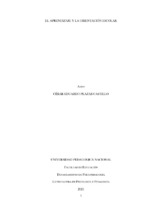El aprendizaje y la orientación escolar.
Citación
Fecha
2021Autor
Plazas Castillo, César Eduardo
Director / Asesor / Tutor
Ardila Rodríguez, Mireya
Palabras claves
Aprendizaje
Orientación escolar
Noción
Plan decenal de educación
Documentos curriculares
Metadatos
Mostrar el registro completo del ítemResumen
En el presente estudio tiene como objetivo analizar las nociones de aprendizaje del corpus tomando como referencias algunas investigaciones de la historia de la Orientación Escolar, documentos emitidos por el Ministerio de Educación Nacional entre ellos: los Planes Decenales de Educación desde 1996 hasta el propuesto 2026, documentos curriculares del área de lenguaje (LC, EBC y DBA) y la normatividad referente a la Orientación Escolar en los que hicieron alusión al aprendizaje. Y, gracias a la diversidad de teorías que giran en torno al aprendizaje se abordó en el marco referencial un recorrido histórico del aprendizaje, desde la teoría conductual hasta los Ambientes de Aprendizaje.
Ya para el desarrollo de la investigación, se escogió la metodología de Análisis de Contenido, “cuya misión consiste en estudiar rigurosamente y sistemáticamente la naturaleza los mensajes de la comunicación” (Krippendorff, 1990, p. 1) que mediante tematizaciones de documentos en categorías y subcategorías, se esquematizaron en matrices de análisis; y con el uso de las TICS, en específico la herramienta Excel y su función de tablas dinámicas.
Abstract
The present study aims to analyze the notions of learning in the corpus, taking as references some investigations of the history of School Guidance, documents issued by the Ministry of National Education, including the Ten-Year Education Plans from 1996 to the proposed 2026, curricular documents of the language area (LC, EBC, and DBA) and the regulations regarding School Guidance in which they alluded to learning. And, thanks to the diversity of theories that revolve around learning, a historical journey of learning was approached in the referential framework, from behavioral theory to Learning Environments.
For the development of the research, the methodology of Content Analysis was chosen, "whose mission is to rigorously and systematically study the nature of communication messages" (Krippendorff, 1990, p. 1) than through thematization of documents in categories and subcategories, were outlined in analysis matrices; and with the use of TICS, specifically the Excel tool and its dynamic table function, I facilitate the compression of the systematization.
Editorial
Universidad Pedagógica Nacional
Programa académico
Licenciatura en Psicología y Pedagogía

